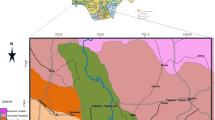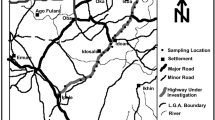Abstract
The quality of highway pavement is greatly influenced by the subgrade materials, the general geology of the area, and the materials used for construction. Investigation into the 75-km Nsukka-Adoru-Idah highway revealed that the pavement was underlain by three lithological units—Imo, Nsukka, and Ajali formations. The geotechnical evaluation carried out in the study includes the particle size distribution, Atterberg limit, specific gravity, compaction tests, and California bearing ratio (CBR). The base course has clay/silt (7–14%), fine sand (1–4%), medium sand (6–13%), and coarse sand (65–86%), while the subgrade presented clay/silt (74–82%), fine sand (6–9%), medium sand (10–17%), and coarse sand (1–3%). The average specific gravity results for the studied base course and subgrades are 2.58 and 2.52. Liquid limit (LL) result ranges from 27 to 60%, while plastic limit (PL) ranges between 17 and 24%, and plasticity index (PI) ranges from 5 to 39%. The maximum dry density (MDD) result ranges from 1.70 to 2.10 mg/m3, while the optimum moisture content (OMC) for the samples ranges between 14.1 and 18.0%. The CBR result for soaked and unsoaked samples ranges from 37 to 74 and 48 to 83%, respectively. The low unsoaked CBR (<80%) and high Atterberg limits (LL > 30% and PI > 12%) failed the stipulated Nigerian standard, signifying the need for stabilization. A geotechnical model of a highway road cut generated a factor of safety of 1.45, indicating possibility of slope failure.











Similar content being viewed by others
References
Adejuwon, J. O., Balogun, E. E., & Adejuwon, S. A. (1990). On the annual and seasonal patterns of rainfall fluctuations in sub-Sahara West Africa. International Journal of Climatology, 10, 839–846.
Aghamelu, O. P., & Okogbue, C. O. (2011). Geotechnical assessment of road failures in the Abakiliki area Southeasten Nigeria. International Journal of Civil and Environmental Engineering, 11(2), 12–21.
Aghamelu, O. P., Nnebo, P. N., & Ezeh, H. N. (2011). Geotechnical and environmental problems related to shales in the Abakaliki area, Southeastern Nigeria. African Journal of Environmental Science and Technology, 5(2), 80–88.
Akpokodje, E. G. (1986). The stabilization of some soils zone with cement and lime. Q.J Engineering Geology, 20, 287–296.
Anyadaike, R. N. C., & Phil-Eze, P. O. (1989). Runoff response to basin parameters in Southern Nigeria. Geografiska Annaler, 71A(1–2), 75–84.
Arora, K. R. (2008). Soil mechanics and foundation engineering (eighth ed.pp. 376–787). New Delhi: Standard Publishers Ltd.
Ayalew, I., & Yamagishi, H. (2005). The application of GIS-based logistic regression for landslide susceptibility mapping in the Kakuda-Yahiko Mountains, Central Japan. Geomorphology, 65(1), 15–31.
Bell, F. G. (2007). Engineering geology (2nd ed.pp. 207–248). London: Elsevier.
Brink, A. B. A., Partridge, T. C., & William, A. A. (1982). Soil survey for engineering: monographs on soil and resource survey. Oxford: Oxford Science Publication.
British Standard Institute BSI (1975). Method of testing stabilized soil B.S 1924. pp. 67–71.
Brooks, A.E., Igwe, O., Una, C.O., Maduka, R.I., & Ajodo, R.O. (2014a). Rainfall induced rock-fall debris avalanche in October 2010, at Kwande Local Government Area of Benue State, Nigeria. India. Journal of the Geological Society of India.
Brooks, A.E., Igwe, O., Una, C.O., Maduka, R.I., & Ajodo, R.O. (2014b). Causes and possible movement of a rock-fall debris/ rock slide at Kwande Local Government Area during the rainy season; In: Proceedings of the discussion session of World Landslide Forum 3, Beijing, China.
Chandler, R. J. (1978). The application of soil mechanics methods to the study of slopes. In J. R. Hails (Ed.), Applied geomorphology: a perspective of the contribution of geomorphology to interdisciplinary studies and environmental management (pp. 157–181). Amsterdam: Elsevier.
Coduto, D.P. (2007). Geotechnical engineering; principles and practices. Prentice Hall of India Private Limited pp 528–529.
Dent, D., & Young, A. (1981). Soil survey and land evaluation. London: George Allen & Unwin.
Douglas, I. (1978). Tropical geomorphology: present problems and future prospects. In C. Embleton, D. Brunsden, & D. K. C. Jones (Eds.), Geomorphology: present problems and future prospects (pp. 162–184). Oxford: Oxford University Press.
Emesiobi, F. C. (2002). Research testing and quality control of materials 1: civil and highway engineering. Port-Harcourt: The Blueprint Limited.
Gbuyiro, S.O., & Orji, B.N.E. (2005). Monitoring of mid-summer drought in West Africa using Global Models. Proceeedings of AMMA workshop, Dakar, Senegal: AMMA Pub. pp. 810–612.
Gokceoglu, C., & Aksoy, H. (1996). Landslide susceptibility mapping of the slopes in the residual soils of the Mengen region (Turkey) by deterministic stability analyses and image processing techniques. Engineering Geology, 44(1), 147–161.
Guzzetti, F., Carrara, A., Cardinali, M., & Reichenbach, P. (1999). Landslide hazard evaluation: a review of current techniques and their application in a multi-scale study, Central Italy. Geomorphology, 31, 181–216.
Igwe, O. (2015a). The geotechnical characteristics of landslides on the sedimentary and metamorphic terrains of south-east Nigeria, West Africa. Geoenvironmental Disasters. doi:10.1186/s40677-014-0008-z.
Igwe, O. (2015b). Stability analysis and simulated hydrologic response of some vulnerable slopes in Nigeria: implications for rainfall-induced landslides. IOSR Journal of Applied Geology and Geophysics (IOSR-JAGG)., 3(3), 48–56. doi:10.9790/0990-03314856.
Igwe, O., Mode, W., Nnebedum, O., Okonkwo, I., Okwara, I., & Mbakwe, I. (2011). Imande-ukusuItulygh landslide. Geophysical Research Abstracts, 13, 2011–1226.
Igwe, O., Mode, W., Nnebedum, O., Okonkwo, I., & Oha, I. (2013). The analysis of rainfallinduced slope failures at Iva Valley area of Enugu State. Nigeria. Environ Earth Sci DOI. doi:10.1007/s12665-013-2647-x.
Ilesanmi, O. O. (1972). Aspects of the precipitation climatology of the July-August rainfall minimum of southern Nigeria. J. Trop.Geogr., 35, 51–59.
Ilesanmi, O.O. (1981). Aspects of the precipitation climatology of the July-August raianfall minimum of southern Nigeria. In: proceeding NGA Regional Planning Committee Seminar on Uban and Regional Problems in Nigeria, University of Ile-Ife.
Ireland, D. H. (1962). The little dry season of southern Nigeria. Nigerian Geogr. J., 5(1), 7–21.
Iverson, R. M. (2000). Landslide triggering by rain infiltration. Water Resources Research, 36(7), 1897–1910.
Lawler, P. (1995). A question of values: Johan Galtungs peace research London: Lynne Rienner.
Monanu, P., & Inyang, F. (1975). Climatic Regimes. In G. E. K. Ofomata (Ed.), Nigeria in maps (pp. 27–29). Benin: Ethiope Publ. House.
Msilimba, G., & Holmes, P. (2010). Landslides in the rumphi district of northern Malawi: characteristics and mechanisms of generation. Natural Hazards, 54(3), 657–677.
Nfor, B.N. (2003). Sedimentary facies and the diagnostic characteristics for the Campanian-Eocene Anambra Basin; unpublished Ph.D. thesis submitted to the Department of Geological Sciences, Nnamdi Azikiwe University, Awka. pp.236.
Nigeria Federal Ministry of Works and Housing (1970). General specification for roads and bridge works. Lagos: Federal Government of Nigeria.
Offordile, M. E. (2002). Ground water study and development in Nigeria. Nigeria: Mecon Geology and Engineering Services Jos.
Ofoegbu, C. O., & Amajor, L. C. (1987). A geotechnical comparison of the pyroclastic rocks from Abakiliki and Ezillo, Southeastern Benue Trough. Journal of Mining and Geology, 23, 45–51.
Ofomata, G.E.K.. (2002). Relief In: GEK Ofomata (Ed.) Survey of Igbo Nations, Africana First Publishers Limited.
Ofomata, G. E. K., & Umeuduji, J. E. (1994). Topographic constraints to urban land uses in Enugu, Nigeria: landscape and urban planning, Amsterdam. Elsevier Science, 28, 129–141.
Okagbue, C. O., & Ochulor, O. H. (2007). The potential of cement stabilized coal reject as a construction material. Bulletin of Engineering Geology and Environment, 66, 143–151.
Okogbue, C. O., & Ezechi, C. (1988). Geotechnical characteristics of soil susceptible to severe gulling in eastern Nigeria. Paris: Bulletin of International Association of Engineering Geology.
Okogbue, C.O., & Ifedigbo, J. (1995). Geotechnical properties of the road cuts of Enugu Onitsha highway. Bulletin of International Association of Engineering Geology.
Ollier, C. D. (1978). Applications of weathering studies. In J. R. Hails (Ed.), Applied geomorphology: a perspective of the contribution of geomorphology to interdisciplinary studies and environmental management (pp. 9–50). Amsterdam: Elsevier.
Petrucci, O., & Polemio, M. (2009). The role of meteorological and climatic conditions in the occurrence of damaging hydro-geologic events in Southern Italy. Natural Hazards and Earth System Sciences, 9, 105–118.
Reidenouer, D. R. (1970). Shale suitability, phase ii: Pennsylvania Department of Transportation, Bureau of Materials, Testing and Research. Interim rep., 1, 198.
Reyment, R. A. (1965). Aspects of the geology of Nigeria (p. 133). Ibadan: University of Ibadan Press.
Sassa, K., Wang, G., Fukuoka, H., Wang, F. W., Ochiai, T., & Sugiyama, S. T. (2004). Landslide risk evaluation and hazard mapping for rapid and long-travel landslides in urban development areas. Landslides, 1(3), 221–235.
Singh, P. (2008). Engineering and general geology, (8th edn) (pp. 409–565). New Delhi: Kataria& Sons.
Sowers, G. B., & Sowers, G. E. (1970). Introduction to soil mechanics and formations (p. 337). London: Macmillan Book Publishing.
Vestappen, H. T. H. (1983). Applied geomorphology: geomorphological surveys for environmental development. Amsterdam: Elsevier.
Wang, F. W., Sassa, K., & Wang, G. (2002). Mechanism of a long-runout landslide triggered by the august 1998 heavy rainfall in Fukushima prefecture. Japan. Eng. Geol., 63(1–2), 169–185.
Wolman, M., & Schick, A. P. (1967). Effects of construction on fluvial sediment in urban and suburban areas of Maryland. Water Resources Research, 3, 451–464.
Yoder, E. J. (1959). Principles of pavement design. New York: John Wiley and Sons Inc..
Youssef, A. M., Pradhan, B., Jebur, M. N., & El-Harbi, H. M. (2014). Landslide susceptibility mapping using ensemble bivariate and multivariate statistical models in Fayfa area, Saudi Arabia. Environment and Earth Science. doi:10.1007/s12665-014-3661-3.
Acknowledgements
The authors acknowledge Engineer Nwachukwu Timothy of Setraco Construction Nigeria Limited and Engineer Ojoh Johnson of the National Steel Raw Materials Exploration Agency, Kaduna, Nigeria, for their efforts in the laboratory. The authors also appreciate all lecturers in the Department of Geology, University of Nigeria, Nsukka, for their valuable contributions.
Author information
Authors and Affiliations
Corresponding author
Rights and permissions
About this article
Cite this article
Maduka, R.I., Igwe, O., Ayogu, N.O. et al. Geotechnical assessment of road failure and slope monitoring along Nsukka-Adoru-Idah highway, Southeastern Nigeria. Environ Monit Assess 189, 30 (2017). https://doi.org/10.1007/s10661-016-5699-z
Received:
Accepted:
Published:
DOI: https://doi.org/10.1007/s10661-016-5699-z




